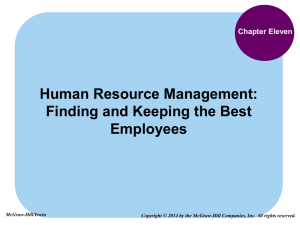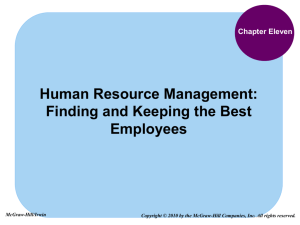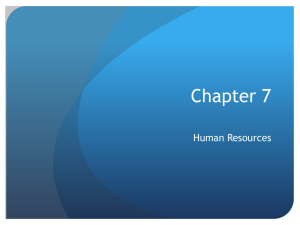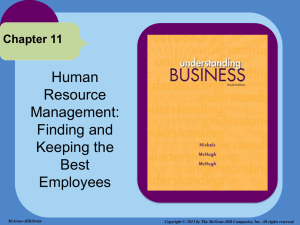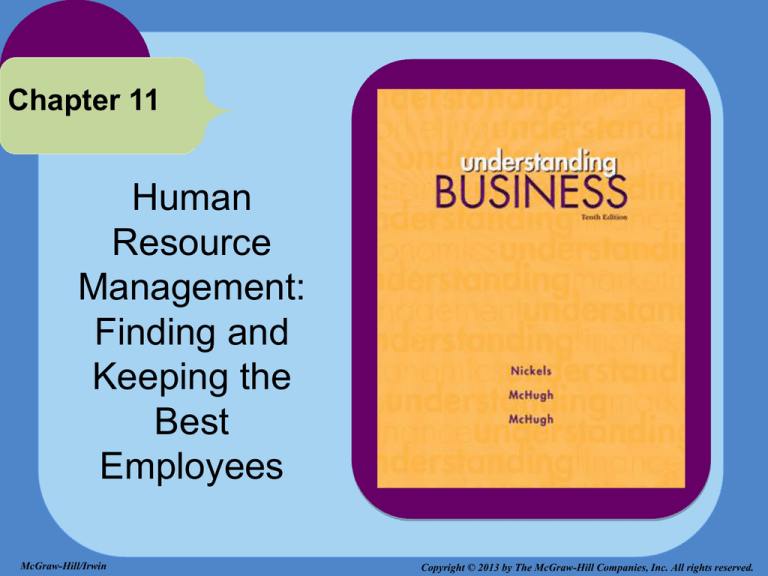
Chapter 11
Human
Resource
Management:
Finding and
Keeping the
Best
Employees
McGraw-Hill/Irwin
Copyright © 2013 by The McGraw-Hill Companies, Inc. All rights reserved.
Chapter Eleven
LEARNING GOALS
1. Explain the importance of human resource
management, and describe current issues in
managing human resources.
2. Illustrate the effects of legislation on human
resource management.
3. Summarize the five steps in human resource
planning.
4. Describe methods that companies use to recruit
new employees, and explain some of the issues
that make recruitment challenging.
11-2
Chapter Eleven
LEARNING GOALS
5. Outline the six steps in selecting employees.
6. Illustrate employee training and development
methods.
7. Trace the six steps in appraising employee
performance.
8. Summarize the objectives of employee
compensation programs, and evaluate pay
systems and fringe benefits.
11-3
Chapter Eleven
LEARNING GOALS
9. Demonstrate how managers use scheduling plans
to adapt to workers’ needs.
10. Describe how employees can move through a
company: promotion, reassignment, termination,
and retirement.
11-4
Working with
People is Just
the Beginning
HUMAN RESOURCE MANAGEMENT
LG1
11-5
Working with
People is Just
the Beginning
LG1
HUMAN RESOURCE
MANAGEMENT (HRM)
• Human Resource Management -- The process
of determining human resource needs and then
recruiting, selecting, developing, motivating,
evaluating, compensating and scheduling employees
to achieve organizational goals.
• HRM’s role has grown because of:
1. Increased recognition of employees as a
resource.
2. Changes in law that rewrote old workplace
practices.
11-6
Developing the
Firm’s
Ultimate
Resource
LG1
DEVELOPING the FIRM’S
ULTIMATE RESOURCE
• Service and high-tech manufacturing requires
employees with highly technical job skills.
• Such workers are scarce,
making recruiting and
retention more important
and more difficult.
• The human resource job is
now the job of all managers
in an organization.
11-7
The Human
Resource
Challenge
LG1
CHALLENGES in FINDING
HIGH-LEVEL WORKERS
• A shortage of trained workers in key areas
• Worker shortage in skilled trades
• An increasing number of baby boomers who
delay retirement
• A declining economy with fewer full-time jobs
• Expanding global markets with low-wage workers
• Increasing benefit demands and benefit costs
• A decreased sense of employee loyalty
11-8
Laws Affecting
Human Resource
Management
CIVIL RIGHTS ACT of 1964
LG2
• Title VII prohibits discrimination in hiring, firing,
compensation, apprenticeships, training, terms,
conditions or privileges of employment based on:
-
Race
Religion
Creed
Sex
Age
National Origin
11-9
Laws Affecting
Human Resource
Management
LG2
1972 EQUAL EMPLOYMENT
OPPORTUNITY ACT (EEOA)
• Strengthened the Equal Employment Opportunity
Commission (EEOC).
• Gave EEOC the right to issue workplace
guidelines for acceptable employer conduct.
• EEOC could mandate specific recordkeeping
procedures.
• EEOC was vested with the power of
enforcement.
11-10
Laws Affecting
Human Resource
Management
LG2
CONTROVERSIAL PROCEDURES
of the EEOC
• Affirmative Action -- Policy designed to “right past
wrongs” by increasing opportunities for minorities
and women.
• Reverse Discrimination -- Discriminating against
members of a dominant or majority group (e.g. whites
or males) usually as a result of policies designed to
correct previous discrimination against minority or
disadvantaged groups.
• This policy has been at the center of many
debates and lawsuits.
11-11
Laws Affecting
Human Resource
Management
LG2
CIVIL RIGHTS ACT of 1991
and OFCCP
• Civil Rights Act of 1991
- Amended Title VII and gave victims of discrimination
the right to a jury trial and possible damages.
• Office of Federal Contract Compliance Programs
(OFCCP)
- Ensures that employers doing business with the
federal government comply with the
nondiscrimination and affirmative action laws.
11-12
Laws Protecting
Employees with
Disabilities and
Older Employees
LG2
LAWS PROTECTING
EMPLOYEES with DISABILITIES
• Americans with Disabilities Act of 1990 (ADA)
- Requires employers to give applicants with physical or
mental disabilities the same consideration for employment as
people without disabilities.
- Passage in 2008 of Americans with
Disabilities Amendments Act
expanded protection.
- 2011 saw new regulations that widen
the range of disabilities covered by
the ADA and shift the burden of proof
of disability from employees to
employers.
11-13
Laws Protecting
Employees with
Disabilities and
Older Employees
LG2
AGE DISCRIMINATION in
EMPLOYMENT ACT (ADEA)
• Age Discrimination in Employment Act (ADEA)
- Protects workers 40 and
over from employment
and workplace
discrimination in hiring,
firing, promotion, layoff,
compensation, benefits,
job assignments and
training.
11-14
Effects of
Legislation
MINDING the LAW in HRM
LG2
• Employers must know the law
and act accordingly.
• Legislation affects all areas of
HRM.
• Court cases highlight that
sometimes it’s proper to go
beyond providing equal rights.
• Changes in law and legislation
occur regularly.
11-15
Determining a
Firm’s Human
Resource Needs
LG3
HUMAN RESOURCE PLANNING
PROCESS
1) Preparing a human resource
inventory of employees.
2) Preparing a job analysis.
3) Assessing future human
resource demand.
4) Assessing future labor
supply.
5) Establishing a strategic plan.
11-16
Determining a
Firm’s Human
Resource Needs
WHAT’S a JOB ANALYSIS?
LG3
• Job Analysis – A study of what employees do who
hold various job titles.
• Job Description – A summary of the objectives of
the job, the type of work, the responsibilities and
duties, working conditions and relationship to other
jobs.
• Job Specifications -- A summary of the minimum
qualifications needed to do a particular job.
11-17
Recruiting
Employees from
a Diverse
Population
RECRUITING EMPLOYEES
LG4
• Recruitment -- The set of activities for obtaining the
right number of qualified people at the right time.
• Human resource managers use both internal and
external sources to recruit employees.
• Small businesses often make use of web
sources like CareerBuilder and Monster to
recruit employees.
11-18
Selecting
Employees Who
Will be
Productive
SELECTION
LG5
• Selection -- The
process of gathering
information and deciding
who should be hired,
under legal guidelines,
to serve the best interest
of the individual and the
organization.
• Contains 6 steps
11-19
Hiring
Contingent
Workers
HIRING CONTINGENT WORKERS
LG5
• Contingent Workers -- Include part-time and
temporary workers, seasonal workers, independent
contractors, interns and co-op students.
• There are about 5.7
million contingent
workers in the U.S.
• Majority of contingent
workers are under 25.
11-20
Hiring
Contingent
Workers
LG5
WHY HIRE
CONTINGENT WORKERS?
• Companies hire contingent workers:
- When full-time workers are on leave
- During periods of peak demand
- In uncertain economic times
- To save on employee benefits
- To screen candidates for future employment
11-21
Training and
Developing
Employees for
Optimum
Performance
LG6
TRAINING and DEVELOPING
EMPLOYEES
• Training and Development -- All attempts to
improve productivity by increasing an employee’s
ability to perform.
• Training focuses on short-term skills.
• Development focuses on long-term abilities.
• 3 Steps: Assess needs; design training;
evaluate training effectiveness
11-22
Training and
Developing
Employees for
Optimum
Performance
LG6
MOST COMMONLY USED TRAINING
and DEVELOPMENT ACTIVITIES
• Orientation
• On-the-Job Training
• Apprenticeships
• Off-the-Job Training
• Online Training
• Vestibule Training
• Job Simulation
11-23
Management
Development
LG6
DEVELOPING EFFECTIVE
MANAGERS
• Management Development -- The process of
training and educating employees to become good
managers and monitoring the progress of their skills
over time.
• Management training includes:
- On-the-job coaching
- Understudy positions
- Job rotation
- Off-the-job courses and training
11-24
Networking
LG6
USING NETWORKS and
MENTORING
• Networking -- Establishing and maintaining
contacts with key managers in and out of the
organization and using those contacts to develop
relationships.
• Mentors -- Managers who supervise, coach and
guide selected lower-level employees by acting as
corporate sponsors.
• Networking and mentoring go beyond the work
environment.
11-25
Appraising
Employee
Performance to Get
Optimum Results
LG7
APPRAISING PERFORMANCE
on the JOB
• Performance Appraisal -- An evaluation that measures
employee performance against established standards in order to
make decisions about promotions, compensation, training or
termination.
• Establishing performance standards (measurable; realistic)
• Communicate standards
• Evaluate standards
• Discuss with employee
• Take corrective action
• Use results to make decisions
11-26
Compensating
Employees:
Attracting and
Keeping the Best
LG8
COMPENSATION PROGRAMS
• A managed and competitive compensation
program helps:
- Attract the kinds of employees the business needs.
- Build employee incentive to work efficiently and
productively.
• Keep valued employees from going to competitors or
starting their own firm.
• Salary / Bonuses / Commissions
• Fringe Benefits
• Profit Sharing
• Stock Options
11-27
Compensating
Teams
COMPENSATING TEAMS
LG8
• Team-based pay programs are more challenging
than individual pay systems.
• The two most common methods for teams
involve:
- Skill-Based: Pay is increased as skill increases.
(Eastman Chemical uses this system.)
- Gain-Sharing: Pay is increased as performance
increases. (Nucor Steel uses this system.)
11-28
Fringe Benefits
LG8
HEALTHCARE, a PERK NOT
to be TAKEN LIGHTLY
• Compare all the costs, not
just premiums.
• Take part in wellness
programs. The average
wellness bonus is $386!
• Order generic drugs when
you need prescriptions
filled.
Source: Kiplinger’s Personal Finance, November 2010.
11-29
Fringe Benefits
LG8
WHO PAYS for
EMPLOYEE BENEFITS?
• 74% of full-time workers
have employee-provided
retirement plans.
• 39% of part-time workers
have employee-provided
retirement plans.
• 71% of workers have
medical care benefits.
Source: Entrepreneur, May 2011.
11-30
Fringe Benefits
LG8
CAFETERIA-STYLE and
SOFT BENEFITS
• Cafeteria-Style Fringe Benefits -- Allow
employees to choose the benefits they want (up to a
certain dollar amount).
• Soft Benefits include:
- Onsite haircuts and shoe repair
- Concierge services
- Free meals at work
- Doggie daycare
- Onsite farmer’s markets
11-31
Flextime Plans
FLEXIBLE SCHEDULING PLANS
LG9
• Flextime Plan -- Gives employees some freedom to
choose which hours to work as long as they work the
required number of hours or complete their tasks.
• Compressed Work Week -- Employees work the
full number of work hours, but in fewer than the
standard number of days.
• Job Sharing -- Lets two or more part-time
employees share on a full-time job.
11-32
Home-Based
Work
HOME-BASED WORK
LG9
• About 10 million Americans telecommute at least
several days a month.
• 12% of U.S. businesses use some home-based
work.
• Bank of America has
My Work that saves
an estimated $5,500
per enrolled
employee every year.
11-33
Moving
Employees Up,
Over and Out
MOVING EMPLOYEES
LG10
• Employees are promoted or
reassigned.
• Employees are terminated due
to performance or economic
situations.
• Employees retire.
11-34
Terminating
Employees
TERMINATING EMPLOYEES
LG10
• As the economic crisis grew, more and more
employers have had to lay off employees.
• Even when the economy is booming, employers
are hesitant to hire full-time workers because of
the cost of termination.
• Firing employees is more
difficult for employers
because of laws preventing
termination for certain acts.
11-35

